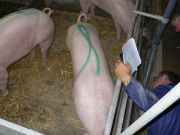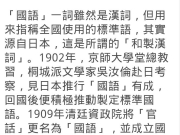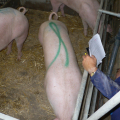|
|
本帖最後由 蘇少儀 於 2014-11-6 18:06 編輯
亞洲金融海嘯之後,美歐日的世紀工程--拉拔中國經濟步上"邁向成熟經濟體"的階段(The Rostow's Stages of Growth model)
Drive to maturity
- diversification of the industrial base; multiple industries expand and new ones take root quickly
- manufacturing shifts from investment-driven (capital goods) towards consumer durables and domestic consumption
- rapid development of transportation infrastructure
- large-scale investment in social infrastructure (schools, universities, hospitals, etc.)
http://en.wikipedia.org/wiki/Rostow%27s_stages_of_growth
在之前的階段中,各國經濟成長都會被稀釋,經濟成長失速,失業率提升......................之後各國的經濟(包括臺灣)會逐步脫離泥沼
台經院上修經濟成長率至3.44% 明年為3.48%
NOWnewsNOWnews – 2014年11月6日 下午4:26..
記者曹逸雯/台北報導
台灣經濟研究院今(6)日發布最新經濟預測,將今年全年的經濟成長率預測值上修至3.44%,較7月時預測的3.28%上修了0.16個百分點;同時預測明(2015)年經濟成長率將可再小幅上升至3.48%。
台經院表示,台灣經濟今年表現轉佳,擺脫過去3年預測與實際之間「開高走低」的窘狀,且上半年經濟成長率也較原先預測來得高,在各項經濟數據中,表現最令人意外的是內需消費,在就業情況改善、股市回溫及觀光客成長的帶動下,前3季民間消費分別成長2.52%、2.53%以及2.43%,不僅是2012年以來的新高且表現穩定。
另外,民間投資及出口也在國際經濟及重要電子產品帶動下保持成長。
台經院也指出,由於全球經濟在第4季又遇亂流,加上地緣政治情勢緊張,以及非洲伊波拉病毒擴散問題的影響,都使得全球金融市場波動加劇,也可能對台灣民眾消費及企業投資信心產生不利影響。
U.S. economic growth sustainable, rates to rise in third quarter 2015
Tue, Jun 17 2014
By Lucia Mutikani
WASHINGTON (Reuters) - The U.S. economy is on a self-sustaining growth path that should allow the Federal Reserve to start raising interest rates in the second half of 2015, according to a Reuters survey of economists.
Despite trimming growth estimates for 2014 because of a dismal first quarter, nearly all of the 48 economists in the survey said the recovery was durable given a decline in uncertainty over fiscal policy and a pick-up in job growth.
"The pieces are in place for a sustained pick-up in activity, and the successful transition to self-sustaining growth will remove one layer of uncertainty and provide the necessary condition for the Fed to consider raising rates," said Millan Mulraine, deputy chief economist at TD Securities in New York.
The survey forecast the economy growing 2.2 percent this year, down from a May projection of 2.5 percent. The median growth forecast for 2015 held at 3.0 percent.
The modest 2014 projection reflects a contraction in the economy in the January-March period, when activity was held back by an unusually cold winter. The government said last month that gross domestic product tumbled at a 1.0 percent annual rate in the first quarter, and many economists expect that already cheerless figure to be revised sharply lower.
While growth is expected to rebound to a rate of about 3.6 percent in the second quarter, GDP growth in the first half of the year will probably come in at just over a 1 percent pace.
Gains in the labor market, which last month recouped all the 8.7 million jobs lost during the recession, were seen underpinning the recovery.
The survey forecast non-farm payrolls expanding by an average of 234,000 jobs per month in the second quarter and maintaining a solid pace of growth through 2015.
It forecast the unemployment rate averaging 6.3 percent this year and falling to an average of 5.8 percent in 2015.
BETTER SENTIMENT
"The collective psyche has improved. We can see that in the various measures of consumer sentiment and in business sentiment as well," said Ryan Sweet, a senior economist at Moody's Analytics in West Chester, Pennsylvania.
"This is very important because businesses will have to continue to hire and invest to keep the economy chugging along."
While the survey forecast tepid wage growth through next year, economists cautioned that a tightening jobs market could yield an upward surprise in average hourly earnings.
With labor market slack easing, the Fed is expected to start raising its benchmark interest rate in the second half of next year. Most economists say the U.S. central bank will likely push overnight rates up to 0.5 percent from their current range of zero to 0.25 percent when it makes its first move.
The Fed, which is already scaling back the amount of money it is injecting into the economy through monthly bond purchases, has held rates near zero since December 2008.
The survey forecast consumer prices, excluding food and energy, bumping against the Fed's 2 percent target in the fourth quarter of this year and hitting the target thereafter.
The core Consumer Price Index was seen averaging 1.9 percent next quarter. It was then forecast rising to 2.0 percent in the final three months of 2014 and holding at that level for the next three quarters.
"If we do get this strong growth that we are forecasting and a move up in inflation, that might get the Fed to start raising rates sooner and be a bit more aggressive," said Scott Anderson, chief economist at Bank of the West in San Francisco.
(Polling by Hari Kishan and Sarbani Haldar in Bangalore; Editing by Sofina Mirza-Reid and Chizu Nomiyama)
© Thomson Reuters 2014. All rights reserved.
EU Cuts Growth Outlook as Inflation Seen Below ECB Forecast By Ian Wishart - Nov 4, 2014
The European Commission cut its growth forecasts for the euro area as the bloc’s largest economies struggle to put the ravages of the debt crisis behind them after two recessions in six years.
Gross domestic product in the 18-nation region will rise by 0.8 percent this year and 1.1 percent in 2015, down from projections for 1.2 and 1.7 percent in May, the Brussels-based commission said today. It lowered its projections for Germany, Europe’s largest economy, and said inflation in the euro area will be even weaker than the European Central Bank predicts.
“The legacy of the global financial and economic crisis lingers on,” said [url=http://search.bloomberg.com/search?q=Marco%20Buti&site=wnews&client=wnews&proxystylesheet=wnews&output=xml_no_dtd&ie=UTF-8&oe=UTF-8&filter=p&getfields=wnnis&sort=date :S:d1&partialfields=-wnnis:NOAVSYND&lr=-lang_ja]Marco Buti[/url], the head of the commission’s economics department. “Slack in the EU economy remains large and is weighing on inflation, which is also being dragged down by tumbling energy and food prices.” :S:d1&partialfields=-wnnis:NOAVSYND&lr=-lang_ja]Marco Buti[/url], the head of the commission’s economics department. “Slack in the EU economy remains large and is weighing on inflation, which is also being dragged down by tumbling energy and food prices.”
The bleaker outlook highlights the fledgling nature of the euro area’s recovery and the deflation threat that has compelled the ECB to take unprecedented stimulus measures. While unemployment is beginning to decline from a record high, core economies such as Germany and France are facing some of the growth challenges that afflicted the periphery at the start of the debt crisis.
Today’s report forecasts inflation at 0.8 percent in 2015, less than half the ECB goal of just under 2 percent. That’s more pessimistic than the central bank’s own projection of 1.1 percent. The commission sees inflation quickening to 1.5 percent in 2016, compared with the ECB outlook for 1.4 percent.
ECB Stimulus European stocks declined for a second day and German, French and Italian bonds rose. The yield on the German 10-year bund fell 4 basis points to 0.81 percent at 11:17 a.m. London time. The Italian yield dropped 5 basis points to 2.37 percent. The Stoxx Europe 600 Index slipped 0.1 percent.
The grim assessment for the euro region comes just days before the ECB Governing Council led by President [url=http://search.bloomberg.com/search?q=Mario%20Draghi&site=wnews&client=wnews&proxystylesheet=wnews&output=xml_no_dtd&ie=UTF-8&oe=UTF-8&filter=p&getfields=wnnis&sort=date :S:d1&partialfields=-wnnis:NOAVSYND&lr=-lang_ja]Mario Draghi[/url] gathers in Frankfurt for its monthly policy meeting. The ECB has cut its benchmark rate to a record-low 0.05 percent and began buying covered bonds to boost inflation and rekindle growth. :S:d1&partialfields=-wnnis:NOAVSYND&lr=-lang_ja]Mario Draghi[/url] gathers in Frankfurt for its monthly policy meeting. The ECB has cut its benchmark rate to a record-low 0.05 percent and began buying covered bonds to boost inflation and rekindle growth.
“Country-specific factors are contributing to the weaknesses of economic activity in the EU and the euro area in particular,” [url=http://search.bloomberg.com/search?q=Jyrki%20Katainen&site=wnews&client=wnews&proxystylesheet=wnews&output=xml_no_dtd&ie=UTF-8&oe=UTF-8&filter=p&getfields=wnnis&sort=date :S:d1&partialfields=-wnnis:NOAVSYND&lr=-lang_ja]Jyrki Katainen[/url], commission vice president for competitiveness, told reporters in Brussels. These include “deep-seated structural problems” and “public and private debt overhang,” he said. :S:d1&partialfields=-wnnis:NOAVSYND&lr=-lang_ja]Jyrki Katainen[/url], commission vice president for competitiveness, told reporters in Brussels. These include “deep-seated structural problems” and “public and private debt overhang,” he said.
The commission predicted GDP growth of 1.7 percent in 2016, lower than the ECB’s 1.9 percent published in September.
‘Fragile’ Recovery Unemployment in the 18-nation region will gradually decrease from 11.6 percent this year, the commission said, forecasting an average rate of 11.3 percent in 2015 and 10.8 percent in 2016.
The recovery is “not only subdued but also fragile,” it said. “With confidence indicators declining since mid-year and now back to where they were at the end of 2013, and hard data pointing to very weak activity for the rest of the year, it is becoming harder to see the dent in the recovery as the result of temporary factors only.”
In addition to a lower forecast for Germany, the commission cut its projections for France and Italy.
Italy’s economy, the third largest in the euro area and in its third recession in six years, will shrink 0.4 percent this year, according to the commission. It predicted growth of 0.6 percent in 2015, half the pace expected in May.
The country’s debt pile -- the second largest in the euro zone after Greece -- will hit 133.8 percent of GDP next year before slipping to 132.7 percent in 2016. That’s still higher than the 132.2 percent anticipated for 2014.
German Stagnation The commission expects Germany to stagnate in the second half. It sees growth of 1.1 percent in 2015 and 1.8 percent in 2016. The 2015 outlook compares with 2 percent in May.
“Growth is set to resume gradually with the support of a robust labor market, favorable financing conditions and improving external demand,” the commission said.
As France spars with EU budget monitors over spending controls, European forecasters see the country’s deficit widening to 4.4 percent of GDP in 2014, compared with a forecast 3.9 percent in May and above the EU’s 3 percent limit. In 2016, the deficit will be 4.7 percent.
France’s structural deficit -- which strips out the effects of the economic cycle -- will deteriorate from 3 percent in 2014 to 3.4 percent in 2016.
Economic growth in Spain is projected to accelerate to 1.7 percent next year and 2.2 percent in 2016 from 1.2 percent this year, underpinned by domestic demand.
The commission said Spain’s budget deficit, pegged at 5.6 percent of GDP this year, will narrow to 4.6 percent in 2015 and to 3.9 percent in 2016.
To contact the reporter on this story: Ian Wishart in Brussels at iwishart@bloomberg.net
To contact the editors responsible for this story: Alan Crawford at acrawford6@bloomberg.net Fergal O’Brien, Andrew Atkinson
®2014 BLOOMBERG L.P. ALL RIGHTS RESERVED
|
|





![越南非洲豬瘟疫苗蒙陰影 上百豬隻接種後死亡[轉貼]](data/attachment/block/3e/3e723490e252eebc3bc1a403febd226e.jpg)

![[轉貼]從上市9頭到14頭 -- 我的養豬專業養成之路。](data/attachment/block/3c/3c17fd6b5c1b8cff34fdc7342238e082.jpg)



![[轉貼]這個倒霉王國,因為一隻老鼠慘遭滅國 .....](data/attachment/block/3f/3ffb7b6b8ec14613dc077bdd7603e3a5.jpg)



 IP卡
IP卡 狗仔卡
狗仔卡 發表於 2014-11-7 09:36:02
發表於 2014-11-7 09:36:02
 :S:d1&partialfields=-wnnis:NOAVSYND&lr=-lang_ja]Marco Buti[/url], the head of the commission’s economics department. “Slack in the EU economy remains large and is weighing on inflation, which is also being dragged down by tumbling energy and food prices.”
:S:d1&partialfields=-wnnis:NOAVSYND&lr=-lang_ja]Marco Buti[/url], the head of the commission’s economics department. “Slack in the EU economy remains large and is weighing on inflation, which is also being dragged down by tumbling energy and food prices.”  提升卡
提升卡 置頂卡
置頂卡 沉默卡
沉默卡 喧囂卡
喧囂卡 變色卡
變色卡 搶沙發
搶沙發 千斤頂
千斤頂 顯身卡
顯身卡 樓主
樓主



![越南非洲豬瘟疫苗蒙陰影 上百豬隻接種後死亡[轉貼]](data/attachment/block/d2/d2539d8909b33105a4f3e3b9b2e8a659.jpg)

![[轉貼]從上市9頭到14頭 -- 我的養豬專業養成之路。](data/attachment/block/81/819f9b837f86a7e00498f8d95b8b9176.jpg)
